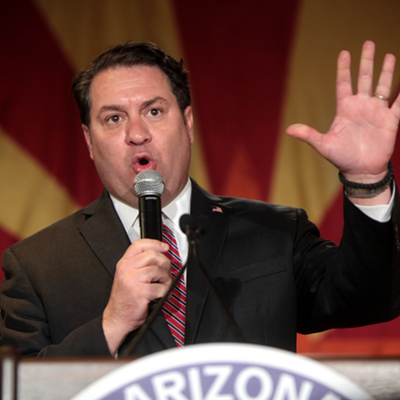AN EMERGING EMERGENCY
Arizona hospitals are seeing their losses mount as more low-income Arizonans lose health-care coverage through AHCCCS, the state's Medicaid program for the poor.
As part of a budget-balancing maneuver earlier this year, state lawmakers cut AHCCCS spending by more than $500,000. Gov. Jan Brewer decided that one of the best ways to implement those cuts was to roll back health insurance for childless adults earning below 100 percent of the federal poverty line. There's a big lawsuit over whether this is legal, which we told you about last week. (See "Weak Prognosis," Dec. 15.)
The cuts to health care do indeed save the state money, but it also means that a lot of people don't have health insurance anymore, so if you have a chronic condition—a bad heart, say, or diabetes—and you can't find work, you're out of luck when it comes to having health insurance.
Beyond the obvious human cost, there's a big price tag for hospitals. Back in the days when AHCCCS covered everyone below the federal poverty level, hospitals could fill out paperwork when someone showed up in the emergency room without insurance. That meant that once that patient was covered under AHCCCS, the state would provide him or her with insurance, and an insurance company would pick up the tab for the emergency-room visit.
But now that the low-income uninsured are no longer eligible for AHCCCS, the hospitals can't count on getting paid for treating them—even though doctors and nurses are still obligated to provide them with care.
As you can imagine, that's a big tab—and it's growing, because the pool of uninsured poor people continues to climb in our lousy job market.
Jim Dickson, the CEO of Bisbee's Copper Queen Hospital, tells The Skinny that in the first five months of the current fiscal year, uncompensated and charity care has more than doubled—from $241,000 in the first five months of the last fiscal year, to $610,000 now.
Even worse, he's seeing the losses grow every month.
"There's no light at the end of the tunnel," Dixon says.
That brings us to one of the most-convoluted elements of the whole thing (and trust us, when you're talking about health care, there are a lot of convoluted elements): When the state stopped funding AHCCCS, it did save the state taxpayers money—but it also cut into the federal funds coming to Arizona, because the federal government essentially provided $2 for every dollar the state spent.
That federal money went to an insurance company, which in turn provided payouts to hospitals when they treated someone who was eligible for coverage under AHCCCS.
That's one reason why the Arizona Hospital and Healthcare Association earlier this year tried to get lawmakers to tax them in order to keep poor people on AHCCCS—they figured that even if they lost some money via a state tax, they'd get more of it back by charging insurance companies for treating AHCCCS patients.
But that plan went nowhere, so now health-care lobbyists are trying to figure out other ways to get those federal dollars, perhaps by finding another way to insure people under AHCCCS, or developing a new program that compensates them for providing care to uninsured patients.
But the hospitals and the Brewer administration need to convince the federal Centers for Medicare and Medicaid Services that the proposals are legit—which isn't as easy as it sounds, especially since the health-care reform passed in 2010—the Affordable Care Act, aka Obamacare—is changing the rules for the states. One key provision of the Affordable Care Act: All states must expand Medicaid coverage to anyone with an income below 130 percent of the federal poverty level. (That provision is at the root of one of the states' challenges to Obamacare in federal court.)
Dickson is working with a consortium of 16 rural hospitals to set up a voluntary tax pool that would allow them to kick in money that would be eligible for the two-to-one federal match; the funds would then be redistributed based on uncompensated care. The Brewer administration has approved the plan, but federal officials are taking their time reviewing the proposal.
Dickson is looking on the bright side of the long process. As he told us last week: "They're taking a long time to make a decision, but I'd rather them take a long time and get a 'yes' than get a quick 'no.'"
IN THE SPIRIT OF THE SEASON
With the end of the year approaching, you're rapidly running out of time to help out a local nonprofit and claim a charitable tax credit—which allows you to get the money back as soon as you file your tax return in 2012.
Under the program, you can give up to $200 (or $400 for a couple filing a joint return) to a charity that helps the working poor.
Given how many cuts that nonprofits have seen as a result of tight state, city and county budgets, the charitable tax credit is a great way to help out folks who are in desperate need—without it costing you a dime.
At the top of our list is the Community Food Bank. The pressure on the nonprofit, which serves Pima, Santa Cruz, Cochise, Graham and Greenlee counties, has been enormous in recent years.
Food Bank CEO Bill Carnegie tells us that four years ago, the Community Food Bank was serving 98,000 people a month. In October of this year, the number had climbed to 240,000. "It's really unprecedented," Carnegie says.
Call 622-0525 for details on donating, or visit communityfoodbank.com.
You might also consider the Primavera Foundation. Peggy Hutchison, the chief executive officer of Primavera, says she's seeing the emergence of a new group of people.
"They've never been homeless before," Hutchison says. "They never expected to be in this situation."
She's seen some success stories—people who have passed through Primavera's rental or transition housing and are now back on their feet—but she's seeing many other problems, too, including people who have health-care needs because they aren't eligible for AHCCCS coverage.
To make a contribution to Primavera, call 623-5111, ext. 107, or go to www.primavera.org.
Or you could give a little to Emerge!, a nonprofit dedicated to helping victims of domestic violence. Emerge!'s Anna Stevens-Denae tells us that as people get more worried about money, relationships are more likely to slip into trouble—and domestic violence is likely to increase.
Emerge! has 120 beds for women who leave abusive partners and need shelter. In October, the organization had to turn away 85 people; in November, it turned away 57. Compare that to 2010, when the shelters turned away an average of 23 women a month.
Emerge! could also use some big, warm blankets, says Stevens-Denae: "We have some throws, but you have to pile three or four of those on a person, so we're in dire need of some full-size blankets."
To make a contribution to Emerge!, call 795-8001, ext. 7013.
There are plenty of other worthy causes, such as Youth on Their Own, which helps homeless teens (293-1136), Casa de los Niños (624-5600) and the Southern Arizona Center Against Sexual Assault (sacasa.org).
Find a complete list of eligible agencies and more details about the working-poor tax credit at azdor.gov/TaxCredits/WorkingPoorTaxCredit.aspx.












